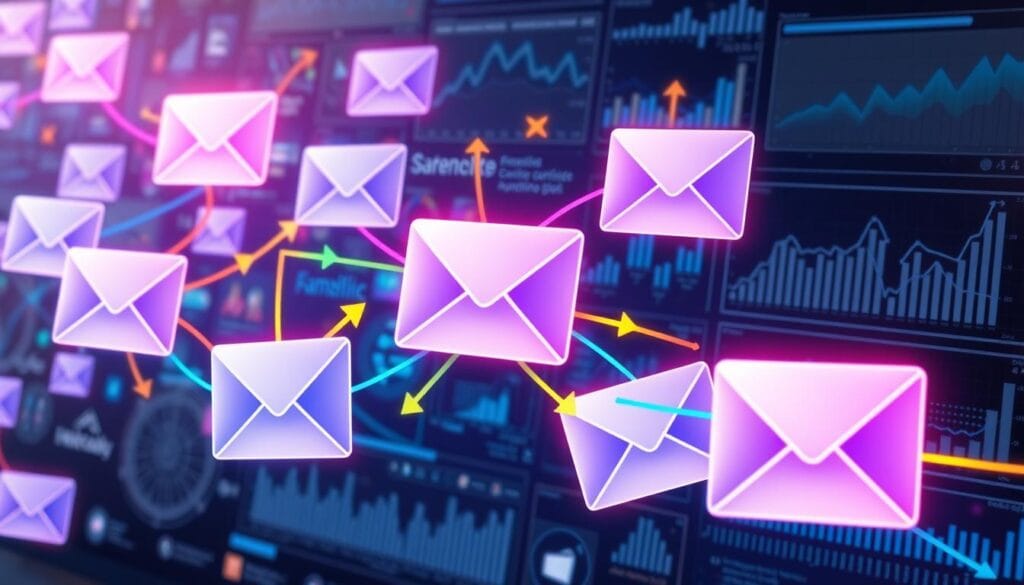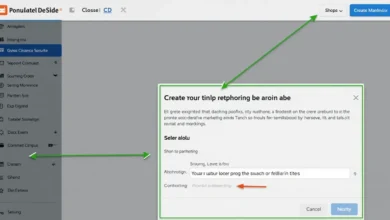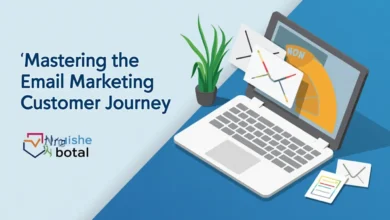nextjs email marketing platform

Welcome to the world of next-generation email marketing with Next.js. This React framework is known for its top-notch performance and efficiency. In this guide, we’ll show you how to use Next.js to create a powerful email marketing platform. It will make your communication smoother, increase engagement, and help you see real results.
If you’re starting out, a seasoned marketer, or a curious developer, this article is for you. We’ll give you a solid base for adding email automation and campaign management to your Next.js apps. You’ll learn about the key parts of email marketing systems and how to use advanced features like subscriber management and campaign analytics.
By the end of this guide, you’ll know how to use Next.js to improve your email marketing. You’ll learn how to work with top email service providers to automate, personalize, and optimize your emails. Get ready to unlock the full potential of your Next.js apps and elevate your email marketing game.
Table of Contents
Understanding Next.js Email Integration Fundamentals
Next.js is a top choice for making modern React apps. It makes adding email marketing and newsletter tools easy. With Next.js, developers can make email features better, improving user experience and communication.
Core Components of Email Marketing Systems
Email marketing needs key parts like managing subscribers, designing templates, automating campaigns, and tracking results. Next.js helps build these parts well. This lets developers make email marketing tools that fit their needs.
Benefits of Server-Side Email Processing
Using Next.js for email marketing has big benefits. It lets developers do email tasks on the server. This makes apps run faster, more reliably, and securely.
Technical Requirements for Implementation
- Knowing Next.js basics like API routes, Server-Side Rendering (SSR), and Static Site Generation (SSG).
- Working with a good email service like SendGrid, Mailgun, or Amazon SES for sending emails.
- Understanding how to design and customize email templates, using tools like Handlebars or Mustache.
- Setting up secure ways to manage who gets emails and their preferences.
- Creating systems to handle errors and logs for email delivery checks.
Meeting these tech needs lets developers add email marketing to Next.js apps smoothly. This creates a better experience for users, boosting engagement and sales.
Popular Email Service Providers for Next.js Applications
There are many email service providers for Next.js apps. Each has its own features, pricing, and ways to integrate. You can pick the one that fits your project best.
SendGrid is a top choice for email marketing with Next.js. It has lots of features like email automation and email deliverability analytics. Mailgun is also popular for transactional emails and has an easy API for Next.js.
Resend is great for those on a budget, offering a free plan and affordable prices for more emails. Brevo, formerly SendinBlue, has tools for all business sizes.
Nodemailer is a Node.js library for sending emails. It works with Gmail, Outlook, and more, making it flexible for developers.
When choosing an email service, think about pricing, features, integration ease, and email deliverability. This ensures you pick the right one for your project and budget.
| Email Service Provider | Key Features | Pricing |
|---|---|---|
| SendGrid | Email automation, list management, analytics | Free plan available, paid plans start at $14.95/month |
| Mailgun | Transactional email services, user-friendly API | Free plan available, paid plans start at $35/month |
| Resend | Cost-effective solution, free plan, scalable pricing | Free plan available, paid plans start at $0.50/1,000 emails |
| Brevo | Comprehensive email marketing tools, user-friendly interface | Free plan available, paid plans start at $25/month |
| Nodemailer | Lightweight, flexible email sending library, supports multiple providers | Open-source, no direct pricing |
Using these email services, you can add powerful email features to your Next.js apps. This boosts user interaction, customer communication, and app success.
Setting Up Your First Next.js Email Marketing Platform
Start your journey with email automation and audience segmentation using Next.js. We’ll show you how to set up your platform. You’ll learn about installing dependencies, setting environment variables, and creating API routes for email handling.
Installing Required Dependencies
First, install the needed packages for your Next.js email platform. You’ll need nodemailer for sending emails, dotenv for environment variables, and Axios for HTTP requests. Use npm or yarn to install them.
Configuring Environment Variables
Next, set up your environment variables. This includes your email service provider’s API key and SMTP credentials. Make sure to keep these variables safe and never share them in your code.
Creating API Routes for Email Handling
Now, create API routes for email handling. Set up endpoints to receive data, process it, and send emails with Brevo. Next.js’s server-side rendering makes email processing secure and efficient.
Building a successful Next.js email marketing platform requires integrating these key components. Follow these steps to create a powerful email automation solution. This will help you connect with your audience effectively.
Email Template Management and Customization
Starting your email marketing journey with Next.js means learning about email templates. These templates are key to your brand’s look in emails. They help keep your brand image consistent in all your emails.
Let’s look at why email templates are important. About 72% of email templates are for order updates like authorization, cancellation, and shipment. Also, 14% are for task notifications, like when a task is activated or approved.
Customizing your email templates is easy with Tailwind CSS classes. You can also add custom fonts using <Font> from @react-email/components. Linking them to Google Fonts ensures your text looks the same everywhere.
Start by using the vercel-invite-user example. You can copy and change it to make your own email templates. For example, you can create a new file called invitation.tsx.
When using images in your templates, make sure they’re hosted in your Next.js project’s public directory. This ensures they show up right in all email clients. Don’t use SVG images, as they might not work in all emails.
“Crafting visually appealing and responsive email templates is key to engaging your audience and delivering a seamless email marketing experience.”
Mastering email template management in Next.js is crucial for a strong email marketing strategy. Keep your templates updated, responsive, and true to your brand. This will help your email templates and newsletter management efforts shine.
Implementing Subscriber Management Systems
Effective subscriber management is key for your email marketing success. As your audience grows, you’ll need a strong system for user lists, double opt-in, and unsubscribe flows. These systems help keep your email list clean and engaged, making your email marketing software work its best.
Database Setup for User Lists
Start by creating a database for your subscriber info. You can use a traditional SQL database or a NoSQL one, based on your needs. Make sure to include important details like email addresses, names, when they subscribed, and any segmentation info.
Double Opt-in Process Implementation
- Start a double opt-in process to check user consent and avoid spam addresses.
- Send a confirmation email with a link or code after someone signs up.
- Add subscribers to your main list only after they confirm their subscription.
Unsubscribe Flow Management
Make sure you have a smooth unsubscribe process. This keeps your audience segmentation clean and engaged.
- Include a clear unsubscribe link in every email.
- Remove users from your list right after they unsubscribe.
- Offer a preference center for users to manage their subscriptions.
By setting up these systems, you’re on your way to a successful email marketing program. It will connect with your audience and help your business grow.
Advanced Email Campaign Analytics and Tracking
As an email marketing pro, you know how key data is. Next.js’s advanced analytics and tracking help you understand your campaigns better. You can see how well they’re doing and make smart choices to improve them.
Comprehensive Reporting and Metrics
Your Next.js platform should have a detailed reporting system. It should track important metrics like open rates, click-through rates, and conversion rates. This info helps you see what works and what doesn’t, so you can make your emails better.
| Metric | Description | Benchmark |
|---|---|---|
| Open Rate | The percentage of recipients who opened your email | 15-25% |
| Click-Through Rate (CTR) | The percentage of recipients who clicked on a link in your email | 2-5% |
| Conversion Rate | The percentage of recipients who took a desired action, such as making a purchase or signing up for a service | 1-3% |
By watching these metrics closely, you can find out what works best. You can then tweak your emails to get even better results. This way, you can keep improving your email analytics and email campaigns.
Integrating with External Analytics Tools
To get even more out of your analytics, link your Next.js platform with tools like Google Analytics or Mixpanel. These tools give you a full picture of your customers’ paths. You can see how they interact with your site and how your emails affect your business.
With these advanced analytics, you can uncover key insights. You can then fine-tune your email marketing plans. This will help you achieve real results with your Next.js email marketing platform.
Email Deliverability and Performance Optimization
In the world of email marketing, getting emails delivered and improving performance is key. Focus on managing your sender reputation, optimizing send times, and handling bounces. This will make your email campaigns more effective and reach your audience better.
Managing Sender Reputation
Your sender reputation is vital for email success. Keep an eye on your email metrics like open rates and spam complaints. Fix any issues quickly and use best practices to improve your chances of getting emails to the inbox.
Optimizing Email Send Times
The timing of your emails matters a lot. Find out when your audience is most likely to open your emails. Test different times and adjust your strategy to get better results.
Handling Bounces and Failed Deliveries
Some emails won’t get delivered. It’s important to handle these situations well. Remove bad email addresses and figure out why emails aren’t getting through. This will help you avoid these problems in the future.
By focusing on these areas, your Next.js email marketing will work better. It will give your subscribers a great experience and help your business grow.

| Email Service Provider | Key Features | Pricing |
|---|---|---|
| SendGrid | Comprehensive email delivery and marketing APIs Tools for improving email deliverability Detailed reporting on email performance metrics Customizable email templates | Pricing starts at $14.95 per month |
| Mailgun | Transactional email API for developers Spam filter and email tracking features Intuitive email editor and template management Detailed analytics and reporting | Pricing starts at $35 per month |
| Mailchimp | User-friendly email marketing platform Automation and segmentation tools Hundreds of pre-designed email templates Comprehensive reporting and analytics | Pricing starts at $11 per month |
Building Automated Email Workflows
Unlock the power of email automation and drip campaigns with Next.js. You can create personalized, triggered email sequences. This engages your audience and drives conversions. Automated email workflows streamline your communication and ensure timely, relevant outreach.
Start by integrating a powerful email service provider like Resend or SendGrid into your Next.js application. Configure the necessary environment variables and API keys. This enables seamless email sending and tracking. With these foundations in place, you’re ready to dive into automated email workflows.
- Define your email triggers: Identify the user actions, events, or time-based factors that should initiate your automated email sequences. This could include new subscriber sign-ups, cart abandonments, or milestone events.
- Craft compelling email templates: Design visually appealing, personalized email templates that resonate with your audience. Leverage dynamic content and merge fields to tailor each message to the recipient’s specific needs and interests.
- Construct email workflows: Utilize tools like Knock to build multi-step email workflows. Customize the flow of messages, conditional logic, and email send times to create a seamless, automated nurturing experience.
- Analyze and optimize: Continuously monitor the performance of your automated email workflows, tracking metrics like open rates, click-through rates, and conversion rates. Refine your email content, timing, and user segmentation to optimize engagement and drive better results.
By harnessing the power of email automation and drip campaigns in your Next.js application, you can automate your marketing efforts. This saves time and nurtures your audience with personalized, timely communications. Unlock the full potential of your email marketing strategy and watch your engagement and conversions soar.
| Feature | Percentage Completed | Pending Tasks |
|---|---|---|
| Search for emails | 100% | – |
| Profile sidebar with user information | 100% | – |
| View all threads | 100% | – |
| View all emails in a thread | 100% | – |
| Compose view | 100% | – |
| Seed and setup script | 100% | – |
| Make side profile dynamic | – | Pending |
| Support Markdown | – | Pending |
| Make up/down arrows work for threads | – | Pending |
| Global keyboard shortcuts | – | Pending |
| Better date formatting | – | Pending |
| Dark mode styles | – | Pending |
The Next.js email client demo app showcases a range of features. These include email composition, search, thread view, and user profile management. Backed by a Postgres database and utilizing the Drizzle ORM, the app provides a solid foundation for building modern email experiences. Explore the live demo at https://next-email-client.vercel.app.
Security Best Practices and Compliance Measures
As an email marketing software provider, keeping your Next.js-based platform secure and compliant is key. Cyber threats are on the rise. So, it’s vital to follow strong security practices and meet standards like GDPR and CAN-SPAM. This protects your audience’s data and keeps their trust.
GDPR and CAN-SPAM Compliance
Following data privacy laws like GDPR and CAN-SPAM is a must for email marketing platforms. You need to get clear consent from users, share your privacy policies, and respect opt-out requests. Not doing so can lead to big fines and harm your brand’s image.
Data Protection Strategies
Protecting user data is a major focus. Use strong encryption, like HTTPS, to keep data safe during communication. Also, watch for data breaches and have a plan ready to handle them.
Authentication and Authorization
Make sure your email marketing software uses top-notch authentication and authorization. This includes two-factor authentication, access controls based on roles, and secure password handling. These steps help stop unauthorized access and protect against account takeovers.
By following security best practices and sticking to regulations, you create a reliable email marketing platform. This builds trust with your audience and keeps their personal info safe.

| Security Measure | Description |
|---|---|
| HTTPS Encryption | Secure communication between the platform and users |
| Two-Factor Authentication | Adds an extra layer of security to user accounts |
| Role-Based Access Controls | Restricts access to sensitive data and features |
| Regular Security Audits | Identify and address vulnerabilities in the platform |
“Cybersecurity is a constantly evolving challenge, and staying ahead of the curve is essential for any email marketing platform that values the privacy and security of its users.”
Conclusion
Building a strong nextjs email marketing platform opens up many opportunities for your web apps. Next.js and email services work together to make email campaigns more engaging and effective. This leads to better customer interaction and business growth.
This guide has covered the basics of email marketing and how to start with Next.js. You now know how to manage subscribers, create dynamic emails, and track your campaigns. Next.js makes these tasks easier and more efficient.
Keep up with the latest in email marketing as you continue to develop your web apps. Use new Next.js features and stay updated to offer top-notch email experiences. With Next.js, you can achieve great things and improve your online presence.
FAQ
What are the core components of a Next.js email marketing system?
A Next.js email marketing system includes several key parts. These are email service integration, email template management, and subscriber list management. It also includes email campaign analytics and automation workflows.
What are the benefits of server-side email processing in a Next.js application?
Server-side email processing in Next.js has many advantages. It improves email deliverability and security. It also allows handling sensitive user data safely on the server.
What are the technical requirements for implementing a Next.js email marketing platform?
To implement a Next.js email marketing platform, you need to install dependencies and set environment variables. You also need to create API routes for email handling. Remember, the specific requirements of your chosen email service provider are important too.
Which email service providers are compatible with Next.js applications?
Next.js works well with several email service providers. These include SendGrid, Mailgun, Resend, Brevo, and Nodemailer. Each provider has unique features and strengths, so choose the one that best fits your needs.
How do I set up a basic email sending functionality in a Next.js application?
Setting up basic email sending in Next.js involves several steps. First, install the needed dependencies and set up environment variables. Then, create API routes for email handling. Make sure to integrate with your chosen email service provider and write the necessary code.
How can I manage and customize email templates in a Next.js application?
To manage and customize email templates in Next.js, use template engines. This lets you create dynamic email content. You can design responsive and attractive email templates that fit your application.
How do I implement a subscriber management system in a Next.js email marketing platform?
Implementing a subscriber management system requires a few steps. First, set up a database for user lists. Then, implement a double opt-in process and manage unsubscribe flows. This keeps your subscriber list clean and engaged.
What techniques can I use to optimize email deliverability and performance in a Next.js email marketing platform?
To improve email deliverability and performance, focus on managing sender reputation. Also, optimize email send times and handle bounces and failed deliveries. Following best practices helps maintain high deliverability rates and improves inbox placement.
How can I create automated email workflows and drip campaigns in a Next.js application?
To create automated email workflows and drip campaigns, use triggered emails. These can be based on user actions or time-based events. This personalizes automated email sequences and boosts engagement through automation.
What security best practices and compliance measures should I consider for a Next.js email marketing platform?
When building a Next.js email marketing platform, consider GDPR and CAN-SPAM compliance. Implement strong data protection strategies and ensure authentication and authorization. Maintaining regulatory compliance and securing user data are key for success.



